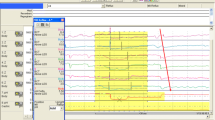Abstract
Background: The detection of gastroesophageal reflux (GER) has to date been limited to acid exposure observed on 24-h pH monitoring. It is clear, however that nonacid reflux can be a significant clinical problem. Recently, as impedance technology with the capacity to detect all types of reflux (acid, nonacid, liquid, mixed, and air) has been developed. Methods: Seventeen asymptomatic healthy volunteers underwent combined 24-h pH and impedance testing. In all patients, pH was measured at 5 cm above the lower esophageal sphincter (LES), and simultaneous impedance changes were recorded at 3, 5, 7, 9, 15, and 17 cm above the LES. Refluxes were classified as acid (drop in pH <4 for >5 sec), Nonacid, short acid, or nonacid delta based on chemical properties; they were further classified as liquid, mixed, or gas based on the physical refluxate detected by impedance changes. The height of the reflux entering the esophagus was classified as distal (<5 cm), intermediate (5–9 cm), or proximal (9–17 cm). Results: A total of 868 reflux events were characterized. Fifty-nine percent of them were not conventional acid reflux and could only be detected by impedance changes. Less than 2% of the events that were detected by a fall in pH to <4 were not detected by impedance changes. Pure liquid reflux was seen in 35.4%, a mixed pattern in 36.3%, and a gas reflux in 26.7%. Liquid was confined to the distal esophagus in 30%; it reached the midesophagus in 58% and the proximal esophagus in 11%. Conclusions: Over half of GER events are not detected by pH studies. Liquid reflux reaches the mid and proximal esophagus 69% of the time and gas nearly always does (92%). The additional information provided by impedance technology is likely to have a major impact on the understanding and clinical management of patients with gastroesophageal reflux disease (GERD).
Similar content being viewed by others
References
DO Castell M Vela (2001) ArticleTitleCombined multichannel intraluminal impedance and pH-metry: an evolving technique to measure type and proximal extent of gastroesophageal reflux. Am J Med 8A 157S–159S Occurrence Handle10.1016/S0002-9343(01)00826-9
C Cortesini G Marcuzzo F Pucciani (1985) ArticleTitleRelationship between mixed acid–alkaline gastroesophageal reflux and esophagitis. Ital J Surg Sci 15 9–15 Occurrence Handle1:STN:280:BiqB3cnosFY%3D Occurrence Handle3997475
B Dreuw J Fass P Buchin J Silny G Rau V Schumpelick (1998) ArticleTitle[Combined pH measurement and multiple impedance variation assessments–validation of a new technique for detection of non-acid reflux in the esophagus]. Langenbecks Arch Chir Suppl Kongressbd 115 1143–1145 Occurrence Handle1:STN:280:DyaK1M7jtVKjuw%3D%3D Occurrence Handle9931817
J Fass J Silny J Braun U Heindrichs B Dreuw V Schumpelick (1994) ArticleTitleMeasuring esophageal motility with a new intraluminal impedance device: first clinical results in reflux patients. Scand J Gastroenterol 29 693–702 Occurrence Handle1:STN:280:ByqD28zmvVI%3D Occurrence Handle7973429
RG Heine DJ Cameron CW Chow DJ Hill AG Catto-Smith (2000) ArticleTitleEsophagitis in distressed infants: poor diagnostic agreement between esophageal pH monitoring and histopathologic findings. J Pediatr 140 14–19
D Sifrim R Holloway J Silny J Tack A Lerut J Janssens (2001) ArticleTitleComposition of the postprandial refluxate in patients with gastroesophageal reflux disease. Am J Gastroenterol 96 647–655 Occurrence Handle10.1016/S0002-9270(00)02391-1 Occurrence Handle1:STN:280:DC%2BD3M7ovFOlsw%3D%3D
D Sifrim R Holloway J Silny Z Xin J Tack A Lerut (2001) ArticleTitleAcid, nonacid, and gas reflux in patients with gastroesophageal reflux disease during ambulatory 24-hour pH-impedance recordings. Gastroenterology 120 1588–1598 Occurrence Handle1:STN:280:DC%2BD3M3ps1Giuw%3D%3D Occurrence Handle11375941
H Skopnik J Silny O Heiber J Schulz G Rau G Heimann (1996) ArticleTitleGastroesophageal reflux in infants: evaluation of a new intraluminal impedance technique. J Pediatr Gastroenterol Nutr 23 591–598 Occurrence Handle10.1097/00005176-199612000-00014 Occurrence Handle1:STN:280:ByiC3sfos1M%3D Occurrence Handle8985851
MF Vaezi SS Shay (2001) ArticleTitleNew techniques in measuring nonacidic esophageal reflux. Semin Thorac Cardiovasc Surg 13 255–264 Occurrence Handle10.1053/stcs.2001.25312 Occurrence Handle1:STN:280:DC%2BD3Mrit1Kjuw%3D%3D Occurrence Handle11568871
MF Vela L Camacho-Lobato R Srinivasan R Tutuian PO Katz DO Castell (2001) ArticleTitleSimultaneous intraesophageal impedance and pH measurement of acid and nonacid gastroesophageal reflux: effect of omeprazole. Gastroenterology 120 1599–1606 Occurrence Handle1:CAS:528:DC%2BD3MXkslGkurk%3D Occurrence Handle11375942
TG Wenzl S Schenke T Peschgens J Silny G Heimann H Skopnik (2001) ArticleTitleAssociation of apnea and nonacid gastroesophageal reflux in infants: investigations with the intraluminal impedance technique. Pediatr Pulmonol 31 144–149 Occurrence Handle1:STN:280:DC%2BD3M3gtlamtA%3D%3D Occurrence Handle11180691
Author information
Authors and Affiliations
Corresponding author
Rights and permissions
About this article
Cite this article
Balaji, N., Blom, D., DeMeester, T. et al. Redefining gastroesophageal reflux (GER) . Surg Endosc 17, 1380–1385 (2003). https://doi.org/10.1007/s00464-002-8859-x
Received:
Accepted:
Published:
Issue Date:
DOI: https://doi.org/10.1007/s00464-002-8859-x




